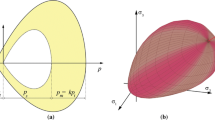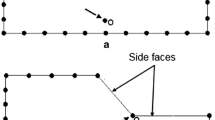Abstract
When they are studied as continuum media, granular materials and other soils and rocks exhibit a complex behavior. Contrary to metals, their isotropic and deviatoric behavior are coupled. This implies some mathematical difficulties concerning boundary-value problems solved with constitutive equations modelling the salient features of such geomaterials. One of the well-known consequences is that the so-called second-order work can be negative long before theoretical failure occurs. Keeping this in mind, the starting point of this work is the pioneering and illuminating work of Nova (1994), who proved that using an isotropic hardening elasto-plastic model not obeying the normality rule, it is possible to exhibit either loss of uniqueness or loss of existence of the solution of a boundary-value problem as soon as the second-order work is negative. Because the geomaterial behavior is quite difficult to model, in practice many different constitutive equations are used. It is then important to study the point raised by Nova for other constitutive equations. In this paper, his result is generalized for any inelastic rate-independent constitutive equation. Similarly the link between localization and controllability proved by Nova (1989) is extended to some extent to a general inelastic model.
Similar content being viewed by others
References
W.T. Koiter, General theorems for elstic plastic solids. In: I.N. Sneddon, R. Hill (eds.),Progress in Solid Mechnics 1 Amsterdam: North Holland Publishing Comp. (1960) pp. 165–221.
Y. Dafalias and I. Popov, Plastic internal variables formalism of cyclic plasticity.J. Appl. Mech. 98 (1976) 645–650.
C. Tamagnini, G. Viggiani and R. Chambon, A review of two different approaches to hypoplasticity. In: D. Kolymbas (ed),Constitutive Modelling of Granular Materials including Developments and Perspectives of Hypoplasticity. Berlin: Springer (1999) pp. 107–145.
O.C. Zienkiewicz and G.N. Pande, Time-dependent multi-laminate model of rocks. A numerical study of deformation and failure of rock masses.Int. Num. Analyt. Methods Geomech. 1 (1977) 219–247.
M. Jirasek and Z.P. Bazant,Inelastic Analysis of Structures. Chichester: John Wiley and sons (2002) 758 pp.
R. Hill, Aspect of invariance in solids mechanics.Adv. Appl. Mech. 18 (1978) 1–75.
B. Raniecki and O.T. Bruhns, Bounds to bifurcation stresses in solids with non associated plastic flow rule at finite strain.J. Mech. Phys. Solids 29 (1981) 153–172.
R. Chambon and D. Caillerie, Existence and uniqueness theorems for boundary-value problems involving incrementally non linear models.Int. J. Solids Struct. 36 (1999) 5089–5099.
D. Bigoni, Bifurcation and instability on non associative elastoplastic solids. In: H. Petryk (ed.),CISM Material Instabilities in Elastic and Plastic Solids. Wien, New York: Springer (1999) pp. 1–52.
R. Nova, Controllability of the incremental response of soil specimens subjected to arbitrary loading programmes.J. Mech. Behav. Materials 5 (1994) 221–243.
S. Imposimato and R. Nova, An investigation on the uniqueness of the incremental response of elstoplastic models for virgin sand.Mech. Cohesive Frict. Material 3 (1998) 65–87.
N. El Hassan,Modélisation théorique et numérique de la localisation de la déformation dans les géomatériaux. PhD thesis, Université Joseph Fourier Grenoble France (1997) 345 pp.
A. Niemunis,Extended Hypoplasticiy for Soils. Habilitation thesis, Bochum, Germany (2002) 191 pp.
H. Petryk, Theory of material instability in incrementally nonlinear plasticity. In: H. Petryk (ed.),CISM Material Instabilities in Elastic and Plastic Solids. Wien, New York: Springer (1999) pp. 261–331.
H. Petryk, General conditions for uniqueness in materials with multiple mechanisms in inelastic deformation.J. Mech. Phys. Solids 48 (2000) 367–396.
J. Rice, The localization of plastic deformation. In: W.D. Koiter (ed.),Proceedings of the International Congress of Theoretical and Applied Mechanics. Amsterdam: North Holland Publishing Comp. (1976) pp. 207–220.
R. Chambon, S. Crochepeyre and R. Charlier, An algorthm and a method to search bifurcation points in non linear problems.Int. J. Num. Methods Engng. 51 (2001) 315–332.
R. Nova, Liquefaction, stability, bifurcation, of soil via strainhardening plasticity. In: Z. Sikora (ed.),Proceedings of the International Workshop on Bifurcation and Localization in Soil and Rocks. Gdansk (1989) pp. 117–131.
R. Chambon and S. Crochepeyre, Daphnis a new model for the description of post-localization behavior: application to sands.Mech. Cohesive Frictl. Material. 3 (1998) 127–153.
R. Chambon and V. Roger, Mohr-Culomb mini CLoE model: uniqueness and localization studies, links with normality rule.Int. J. Num. Analyt. Methods Geomech. 27 (2003) 49–68.
C. Dascalu, I. R. Ionescu and M. Campillo, Fault finitness and initiation of dynamic shear instability.Earth Planet. Sci. Lett. 177 (2000) 163–176.
Author information
Authors and Affiliations
Rights and permissions
About this article
Cite this article
Chambon, R. Some theoretical results about second-order work, uniqueness, existence and controllability independent of the constitutive equation. J Eng Math 52, 53–61 (2005). https://doi.org/10.1007/BF02694030
Received:
Accepted:
Issue Date:
DOI: https://doi.org/10.1007/BF02694030




